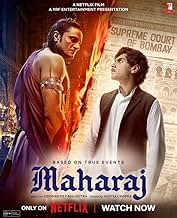Baseado em um caso histórico real, um jornalista ousado questiona o comportamento imoral de um líder reverenciado.Baseado em um caso histórico real, um jornalista ousado questiona o comportamento imoral de um líder reverenciado.Baseado em um caso histórico real, um jornalista ousado questiona o comportamento imoral de um líder reverenciado.
- Prêmios
- 3 vitórias e 13 indicações no total
- Direção
- Roteiristas
- Elenco e equipe completos
- Produção, bilheteria e muito mais no IMDbPro
Enredo
Você sabia?
- CuriosidadesDebut of Junaid Khan.
Avaliação em destaque
"Maharaj," directed by Siddarth P. Anand, is a compelling historical drama that revisits the landmark Maharaj Libel Case of 1862. With an engrossing storyline, powerful performances, and meticulous attention to historical detail, the film offers a vivid portrayal of a pivotal moment in Indian legal history and society.
Plot Summary The film centers on the Maharaj Libel Case, a significant legal battle in Bombay during the British Raj. The case involves a young journalist, played by Junaid Khan, who exposes the immoral activities of a powerful religious leader from the Vaishnav sect, portrayed by Jaideep Ahlawat. The resulting defamation lawsuit becomes a landmark case, highlighting the clash between truth and power, and the fight for justice and moral integrity.
Acting Performances Junaid Khan delivers a breakout performance as the courageous journalist. His portrayal of a principled young man standing up against corruption and hypocrisy is both compelling and inspiring. Khan's nuanced acting captures the internal struggles and resilience of his character, making his journey profoundly relatable.
Jaideep Ahlawat is equally formidable as the antagonist. His depiction of the charismatic yet morally corrupt Maharaj is chilling. Ahlawat's ability to convey the complexities of a powerful figure facing public scrutiny adds significant depth to the narrative. His performance ensures that the character is not just a one-dimensional villain, but a person with his own vulnerabilities and manipulations.
Direction and Cinematography Siddarth P. Anand's direction is masterful, showcasing his talent for creating a rich, immersive historical setting. His eye for detail is evident in the meticulous recreation of 1860s Bombay, bringing to life the bustling streets, colonial architecture, and socio-political atmosphere of the era. Anand's ability to balance the dramatic courtroom scenes with the broader social context of the time is commendable, making the narrative both gripping and educational.
Historical and Cultural Context The film delves deep into the Vaishnav sect, exploring its beliefs, practices, and the influence of its leaders during the British Raj. Anand presents a balanced view of the sect, highlighting its spiritual significance while also critiquing the corruption that can arise within any institution. This contextual richness adds layers to the story, making it not just a legal drama, but a commentary on the complexities of faith and power.
Set Design and Production Values The set design in "Maharaj" is outstanding, capturing the essence of 19th-century Bombay with impressive authenticity. The attention to detail in the costumes, props, and settings creates a visually captivating experience. The production team's dedication to historical accuracy extends to every aspect of the film, from the grand courtrooms to the modest homes and bustling marketplaces. This meticulous craftsmanship immerses the audience in the period, enhancing the storytelling.
Conclusion "Maharaj" is a powerful and thought-provoking film that excels in both storytelling and historical representation. The performances of Junaid Khan and Jaideep Ahlawat are stellar, bringing depth and intensity to their characters. Siddarth P. Anand's direction ensures that the film is not only a compelling legal drama but also a rich historical tapestry that sheds light on an important chapter in Indian history.
With its engaging narrative, strong performances, and impeccable production values, "Maharaj" stands out as a significant contribution to contemporary Indian cinema. It is a film that challenges, inspires, and transports the audience to a crucial moment in time, reminding us of the enduring struggle for truth and justice.
Plot Summary The film centers on the Maharaj Libel Case, a significant legal battle in Bombay during the British Raj. The case involves a young journalist, played by Junaid Khan, who exposes the immoral activities of a powerful religious leader from the Vaishnav sect, portrayed by Jaideep Ahlawat. The resulting defamation lawsuit becomes a landmark case, highlighting the clash between truth and power, and the fight for justice and moral integrity.
Acting Performances Junaid Khan delivers a breakout performance as the courageous journalist. His portrayal of a principled young man standing up against corruption and hypocrisy is both compelling and inspiring. Khan's nuanced acting captures the internal struggles and resilience of his character, making his journey profoundly relatable.
Jaideep Ahlawat is equally formidable as the antagonist. His depiction of the charismatic yet morally corrupt Maharaj is chilling. Ahlawat's ability to convey the complexities of a powerful figure facing public scrutiny adds significant depth to the narrative. His performance ensures that the character is not just a one-dimensional villain, but a person with his own vulnerabilities and manipulations.
Direction and Cinematography Siddarth P. Anand's direction is masterful, showcasing his talent for creating a rich, immersive historical setting. His eye for detail is evident in the meticulous recreation of 1860s Bombay, bringing to life the bustling streets, colonial architecture, and socio-political atmosphere of the era. Anand's ability to balance the dramatic courtroom scenes with the broader social context of the time is commendable, making the narrative both gripping and educational.
Historical and Cultural Context The film delves deep into the Vaishnav sect, exploring its beliefs, practices, and the influence of its leaders during the British Raj. Anand presents a balanced view of the sect, highlighting its spiritual significance while also critiquing the corruption that can arise within any institution. This contextual richness adds layers to the story, making it not just a legal drama, but a commentary on the complexities of faith and power.
Set Design and Production Values The set design in "Maharaj" is outstanding, capturing the essence of 19th-century Bombay with impressive authenticity. The attention to detail in the costumes, props, and settings creates a visually captivating experience. The production team's dedication to historical accuracy extends to every aspect of the film, from the grand courtrooms to the modest homes and bustling marketplaces. This meticulous craftsmanship immerses the audience in the period, enhancing the storytelling.
Conclusion "Maharaj" is a powerful and thought-provoking film that excels in both storytelling and historical representation. The performances of Junaid Khan and Jaideep Ahlawat are stellar, bringing depth and intensity to their characters. Siddarth P. Anand's direction ensures that the film is not only a compelling legal drama but also a rich historical tapestry that sheds light on an important chapter in Indian history.
With its engaging narrative, strong performances, and impeccable production values, "Maharaj" stands out as a significant contribution to contemporary Indian cinema. It is a film that challenges, inspires, and transports the audience to a crucial moment in time, reminding us of the enduring struggle for truth and justice.
- abphadore
- 20 de jun. de 2024
- Link permanente
Principais escolhas
Faça login para avaliar e ver a lista de recomendações personalizadas
- How long is Maharaj?Fornecido pela Alexa
Detalhes
- Data de lançamento
- País de origem
- Central de atendimento oficial
- Idioma
- Também conhecido como
- Maharaj
- Locações de filme
- Empresa de produção
- Consulte mais créditos da empresa na IMDbPro
- Tempo de duração2 horas 11 minutos
- Cor
- Mixagem de som
Contribua para esta página
Sugerir uma alteração ou adicionar conteúdo ausente


































